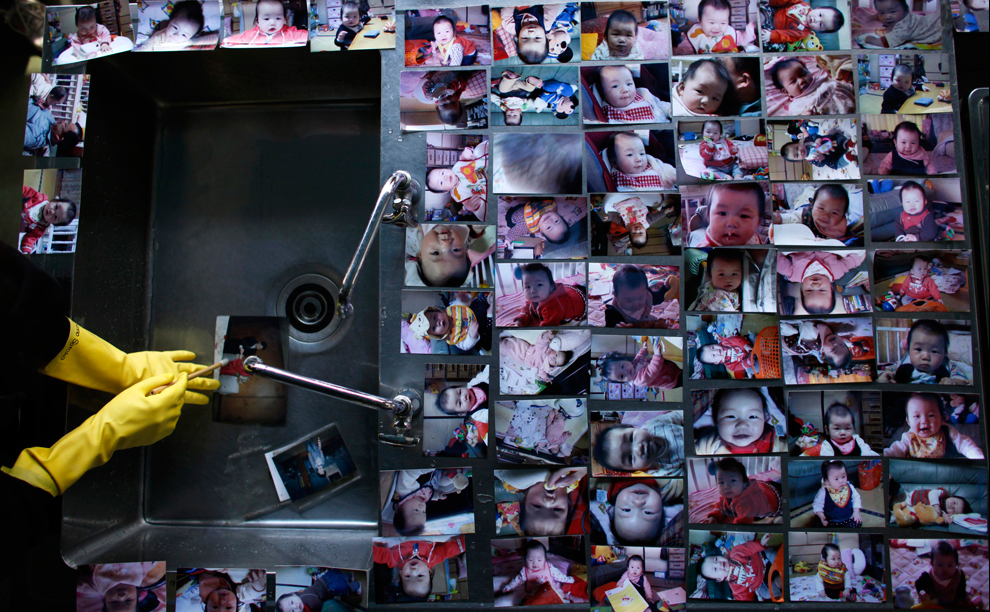Last month I commented on the profusion of photographs showing up in slideshows reporting on the discovery of snapshots and family photo albums in the detritus left in the wake of the earthquake and tsunami in Japan. The title of the post, “The Family of Man,” was borrowed from the most famous photo exhibition ever, curated by Edward Steichen in the 1955 and viewed by more than nine million people throughout the world. The point of the exhibit was to call attention to a common humanity that presumably transcended cultural differences worldwide, and the point of my post was to underscore the way in which the snapshot or family photo album was a modern affectation that marked something of a common humanity designed to activate a powerful stranger relationality. On reflection, however, I believe that I was only partially correct and there is much more to be said.
The photograph above appeared on the front page of the NYT this past week (4/13/11), occupying the top half of the page above the fold. Prime space! It was not connected to any front page story. The caption notes that they are photos that had been damaged by the March Tsunami and had been recovered, cleaned, and left to dry. And indeed, the image indicates both the magnitude of the task and the almost surgical care with which it is being executed. These photographs, snapshots that one might find in any family photo album, clearly matter. And it should not escape notice that they are all photographs of beautiful young children, markers of both the modern family and the national future. There are many other similar photographs of such snapshots floating about the web and I probably would have ignored this one but for the prominent placement in the newspaper and the second sentence of the caption: “The nuclear alert level was raised on Tuesday.” The apparent non sequitur notwithstanding, I was struck by how a people ravaged by a devastating natural disaster and facing a continuing and dangerous nuclear emergency nevertheless have the time and resources to recover and preserve the family photographic record. And I was struck too by the fact that the NYT would feature it without connecting it to an apparently relevant news article. My original point about the importance of representing a common humanity and a powerful stranger relationality seemed secure.
But then this week I learned that three WP photographers had just won the Pulitzer Prize for their work on last year’s earthquake in Haiti. The photographs focus on bodies. Many of the images are grotesque and the overall affect is gut wrenching. But more to the point, they collectively evoke a sense of pity, rather than a common humanity or stranger relationality. One doesn’t find such photos in any of the slide shows reporting on the disaster in Japan, where the emphasis is on destruction to infrastructure and advanced technology—a point vaguely gestured to by the caption for the photograph above concerning the nuclear alert level. And when one does see pictures of bodies in the archive of Japanese images they are invariably treated with a profound funeral respect. One might feel sorrow in the face of such images, but not pity. More to the point, not a single one of the WP photographs includes an image of a lost or found snapshot or photo album. And lest the sample seem too small, a search of the hundreds of photographs of the Haitian disaster that appeared in the NYT, or in slideshows at websites like the Boston Globe’s Big Picture or totallycoolpix.com, confirms the point.
There may be reasons that explain this, to be sure. Japan is a modern society with a technologically advanced infrastructure, Haiti is an economically undeveloped country mired in massive poverty. In short, all Haiti had to lose were bodies. And yet for all of that, the disparity of visual representation is telling. When we look West to Japan we see something rather like ourselves, and the themes and conventions of dignity and decorum that we employ in such representations are the ones that we would employ in representing ourselves. When we look beyond our borders to the South, however, we see something altogether different, an otherness marked by a shift in both theme and the stylistic tokens of propriety. And, oddly enough, the distinction here between looking West and South is signified correspondingly by the presence and absence of snapshots and family photo albums, cultural artifacts which, in the end, are less about the family of man and the powerful stranger relationality it purports to animate, and more about the conventions of a narrow and particular kind of economic and technological modernity.
Photo Credit: Toru Hanai/Reuters

Images of corpses violate our emotional and aesthetic senses–unless the bodies are alien. News photographers perpetuate an unremarked sense of us and them, and of Otherness–and they continue to receive awards for this practice. Were Haitian bodies worthy of our pity, but not our respect? As a nation of poverty-stricken, less modern/more primitive “Others,” is their plight alien and somewhat contemptible to us? News images of disasters are not so subtly valenced to convey a sense of worth (or lack thereof) in the victims. I noticed–and was appalled by–the intrusive documentation of Haiti deaths after the earthquake. The only comparable images I recall were of dark bodies, floating or crumpled in death, in the aftermath of Katrina. There are doubtless grotesque images of Japanese casualties, but photographers are discrete and discerning about images of their tragedy because shooters regard the Japanese, unlike Haitian people or Katrina victims, as inherently worthy of respect. Photographers create and maintain distinctions between who is worthy of discrete and detached coverage of death, and who is objectified in images that would shock us if they weren’t so DARK.